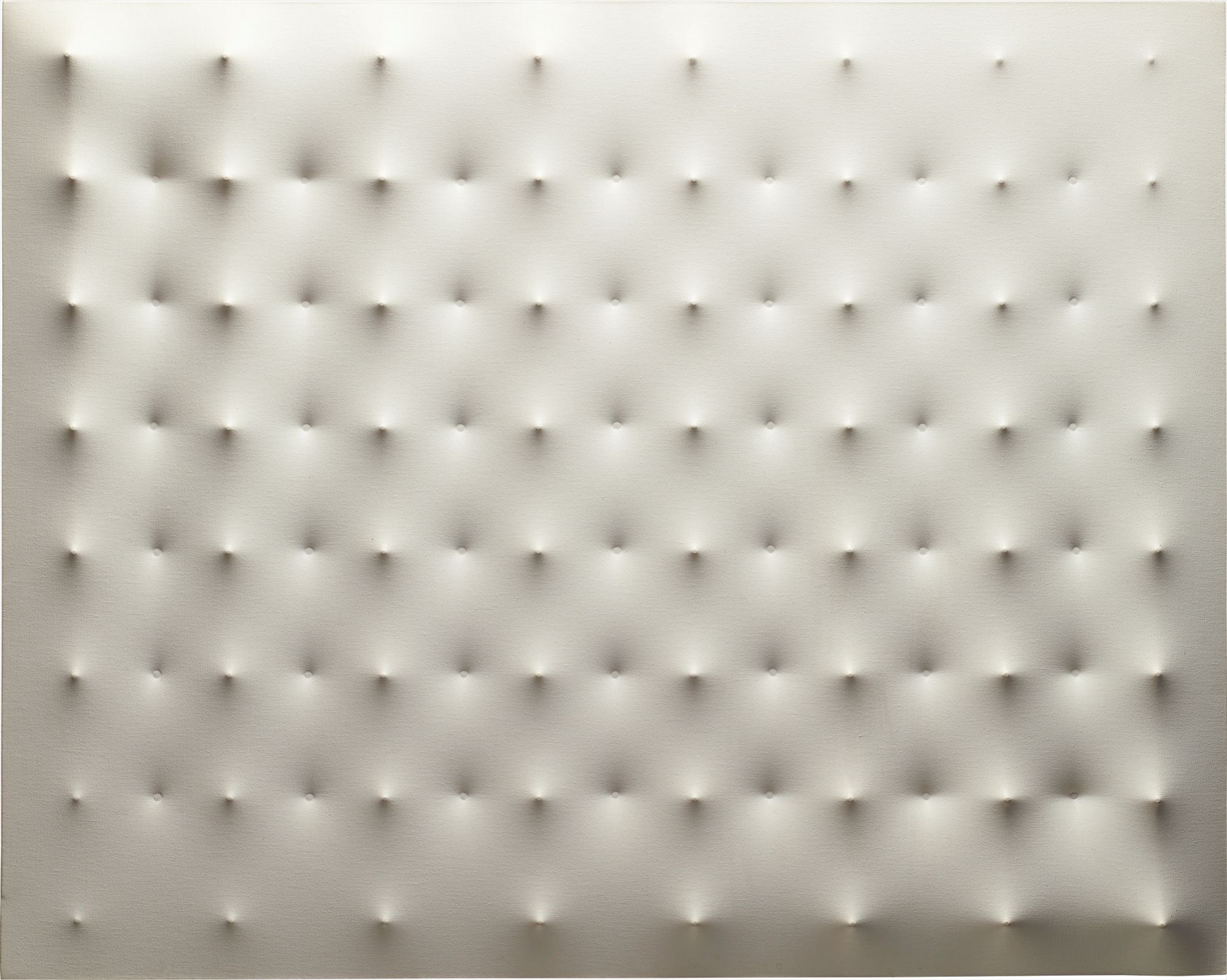

23Ο
Enrico Castellani
Superficie bianca
signed, titled and dated 'Enrico Castellani "Superficie bianca" 1979' on the overlap
acrylic on shaped canvas
80 x 100 cm (31 1/2 x 39 3/8 in.)
Executed in 1979, this work is registered in the Archivio Castellani, Milan, under no. 79 - 031.
Full-Cataloguing
A celebrated pioneer of subverting preconceived ideas of representation and beauty, Enrico Castellani created his iconic monochromatic reliefs by driving nails through the back of his canvases. Executed in 1979, Superficie Bianca is exemplary of the artist’s most iconic series - the Superfici. With its ordered arrangement of positive and negative poles, this work is a captivating paradigm of minimalism and elegance. Painted in white acrylic, Superficie Bianca is filled with a dynamic tension, displaying the artist’s innovative technique which he embraced in response to the ethos heralded in the influential gallery and accompanying journal Azimuth, co-founded with Piero Manzoni in 1959.
Azimuth’s place in the landscape of Italian art, a great catalyst of conceptual culture, served as a rational bridge between revolutionary ideas and contemporary artistic advances. Disassociating themselves from Taschisme and Art Informel, Manzoni and Castellani presented new artistic approaches. Interrogating light, surface, space and time, both artists harnessed their new creative language to establish Milan as an essential core of ZERO activity. Liberating the artist from the traditional constraints of painting, Castellani forged key alliances with the likes of Lucio Fontana, Otto Piene and Yves Klein, a pivotal international network of artists, all committed to redefining art within the ZERO movement.
Displaying the artist’s lifelong investigation into surface and form, the work transports the viewer into a world of dashing undulation and protrusion, a delicate topography of peaks and troughs. The monochrome surface, acting as a tabula rasa in its objectivity and anonymity, has a limitless, sublime quality. Believing in the potential of art freed from narrative constraints, Castellani creates a poetic marriage of painting, sculpture and architecture.
Approaching Superficie Bianca, the viewer is forced to acknowledge the physicality of the systematically arranged nails, pressed against the canvas from behind, the surface punctuated with undulating reliefs and depressions. Working the canvas with a nail gun to shape patterns of concavity and convexity, areas of the plane are cast in bright light and others into deep shadow. As the oscillating effects of his intricate protrusions change with each alternation, Superficie Bianca is instilled with a life on its own. Appropriating a sculptural syntax, Castellani achieves an illusionary effect, reminiscent of the traditional Italian painting method of chiaroscuro, pioneered by Leonardo da Vinci. Spanning the bridge between sculpture and painting, Superficie Bianca defies two-dimensionality. Freed from representative constraints this work encourages the viewer to look beyond the picture plane, producing disorienting effects through the play of cast shadows and angled surfaces, reminding the viewer that a painting is, in fact, a physical object and not just an illusionistic window.
Azimuth’s place in the landscape of Italian art, a great catalyst of conceptual culture, served as a rational bridge between revolutionary ideas and contemporary artistic advances. Disassociating themselves from Taschisme and Art Informel, Manzoni and Castellani presented new artistic approaches. Interrogating light, surface, space and time, both artists harnessed their new creative language to establish Milan as an essential core of ZERO activity. Liberating the artist from the traditional constraints of painting, Castellani forged key alliances with the likes of Lucio Fontana, Otto Piene and Yves Klein, a pivotal international network of artists, all committed to redefining art within the ZERO movement.
Displaying the artist’s lifelong investigation into surface and form, the work transports the viewer into a world of dashing undulation and protrusion, a delicate topography of peaks and troughs. The monochrome surface, acting as a tabula rasa in its objectivity and anonymity, has a limitless, sublime quality. Believing in the potential of art freed from narrative constraints, Castellani creates a poetic marriage of painting, sculpture and architecture.
Approaching Superficie Bianca, the viewer is forced to acknowledge the physicality of the systematically arranged nails, pressed against the canvas from behind, the surface punctuated with undulating reliefs and depressions. Working the canvas with a nail gun to shape patterns of concavity and convexity, areas of the plane are cast in bright light and others into deep shadow. As the oscillating effects of his intricate protrusions change with each alternation, Superficie Bianca is instilled with a life on its own. Appropriating a sculptural syntax, Castellani achieves an illusionary effect, reminiscent of the traditional Italian painting method of chiaroscuro, pioneered by Leonardo da Vinci. Spanning the bridge between sculpture and painting, Superficie Bianca defies two-dimensionality. Freed from representative constraints this work encourages the viewer to look beyond the picture plane, producing disorienting effects through the play of cast shadows and angled surfaces, reminding the viewer that a painting is, in fact, a physical object and not just an illusionistic window.